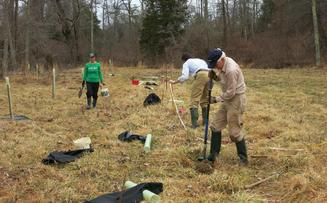By Harry Kollatz Jr.
It was one of the first big lies the English settlers told the native Powhatan people. The cross planted on a small island on the afternoon of May 24, 1607, near the falls of the James by Captain Christopher Newport entered legend almost as soon as the one-armed commodore shoved it into the ground...
...Newport told the wary Powhatan that it symbolized the forging of a bond between his people and theirs. Never mind that the wood planks bore the crude legend "Jacobus Rex, 1607" for King James. Newport represented the leading edge of British expansion. The English on that afternoon were, as they perceived the situation, one step ahead of the cruel and hated papist Spanish.
The night before, the "adventurers" were accorded hospitality through rituals of tobacco smoking, feasting and dance. The English expeditionary force, just a week after beginning construction of James Fort (Jamestown), met with the original residents in a hilltop village called Powhatan, perhaps on the site of today's Tree Hill Farm, just across the Richmond limits in eastern Henrico. The site may have also been the birthplace of the region's paramount chieftain, Powhatan. The place was administrated by Parahunt, one of Powhatan's many sons.
During evening entertainment illuminated by flickering fires, the English prodded their hosts about what was upriver and the distance to the mountains. Parahunt wasn't keen to answer and he avoided the subject. The river coursed through the territory of the often-hostile Monacan tribe, into a mountainous country called Quirank. Beyond it was what the English sought to interpret as a large body of water—the Indian Ocean. On May 24, 1607, after lunch provided by their hosts, Parahunt and a guide, Nauiraus, led Newport and company to the falls.
The group's historian, Gabriel Archer, recalled the river as "full of huge rocks." He saw a large island about a mile away and alongside the river "high hills which increase in height one above another as far as we saw." The dramatic site overlooking rocks and rapids was near the north end of the present Mayo's or Fourteenth Street Bridge and occupied by the Southern Railway freight building. This is where First Market Bank headquarters and Morton's Steakhouse are situated, near the Canal Walk’s turning basin.
The Powhatan tried dissuading the English from further travel. In A Relation of Discovery, attributed to Archer, the writer describes "sitting upon the bank by the overfall, beholding the same" while their native guide, Nauiraus, with Parahunt at his side, began describing “the tedious travel” to be faced if the explorers continued. The village of the Monacan, enemies of Parahunt, was a day and a half away. It seemed best not to rile the Monacan with strange white faces whom the Powhatan's enemies would assume were sent by Parahunt. Besides, journeying to Quirank would exhaust them and they’d have trouble securing food for such a long journey
The English were eager to push on. Newport, acting diplomat, heeded Parahunt's advice. But he wanted to indicate the company’s westernmost advance. Newport placed the simple wood cross with the king’s name above and his below. Parahunt well enough understood the symbolism, and angered, he left. Newport explained to those who remained, through Nauiraus, that the cross meant union, not domination.
The party then gave a shout of celebration while the Powhatan looked on. After this ceremony, the English found Parahunt, calmed him and the duped native prince gave them a kind farewell. As the explorers pulled away in their boat, both native and newcomer gave parting cries of friendship.
On June 10, 1907, the Association for the Preservation of Virginia Antiquities dedicated a copper cross upon a pyramid of James River granite on Gamble's Hill at the base of Fourth Street. At that time, it seemed to overlook the general place where Newport had placed his cross.
Judge David C. Richardson, a future Richmond mayor, on the warm, drizzly afternoon said, "From the time when Jacob erected a pillar at Betheldown to the present day, it has been the custom of nations and peoples to mark the spots at which important events have occurred by some enduring memorial."
The Gamble's Hill site became a tourist attraction and favorite promenading spot, for the view of the rapids, the industrial might of Tredegar Iron Works and the whimsical turreted and crenellated Pratt's Castle, made of rolled sheet iron, scored and painted to resemble the stones upon which it sat.
In 1983, after a land swap with Ethyl Corporation, the memorial was removed to Shockoe behind the Martin Agency nearer the probable site. The peripatetic pile and cross were moved once again in 2003 to the bottom of Twelfth Street along the canal walk, even closer to the actual location.
This story has been republished from Harry Kollatz Jr.'s book True Richmond Stories, courtesy of The History Press.
Comment
You Might Also Like
Henricus Historical Park
Take a step back in time to the "Commonwealth of Henrico". This outdoor living history museum represents the various aspects of early life in Virginia's second settlement.
An Attack in Defense- March 22, 1622
Some of the most important and interesting American history took place along the James River, and the Indian Uprising of March 22, 1622 is no exception. On this Good Friday four centuries ago, Algonquian Indians loyal to Powhatan’s predecessor,…
Jamestown: Birthplace of the Nation
The Far East has its Mecca, Palestine its Jerusalem, France its Lourdes, and Italy its Loretto, but America's only shrines are her altars of patriotism - the first and most potent being Jamestown; the sire of Virginia, and Virginia the mother of …









